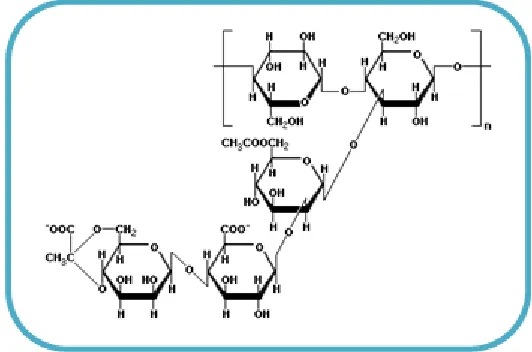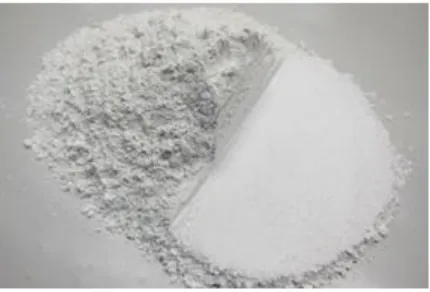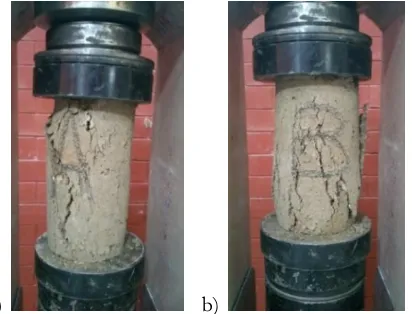Copyright © The Author(s). All Rights Reserved. Published by American Research Institute for Policy Development DOI: 10.15640/jea.v6n1a3 URL: https://doi.org/10.15640/jea.v6n1a3
The Behavior of Poured Earth in Addition with two Stabilizers Using Soil
Denominated Champayán from Altamira, Tamaulipas
Erick Zarazúa-Portes
1, Yolanda G. Aranda-Jiménez
2María T. Sánchez-Medrano
3&
Carlos A. Fuentes-Pérez
4Abstract
In the search for sustainable constructive procedures, it appears that poured earth is a mixture of floors with stabilizing elements that generate an acceptable resistance to compression, for the construction of load bearing walls, as part of a subsystem for buildings. It is possible to experiment with other stabilizers of natural origin such as lime or xanthan gum that could have similar or superior results in strength, but above all in cement reduction. Showing results obtained in terms of compressive strength of mixtures stabilized with xanthan gum, to reduce the amount of Portland cement and obtain similar results, as well as dosages with other stabilizers. Four models of three test pieces of 15 x 30 cm each were prepared separately by adding the corresponding stabilizer to the soil. In this study, the compressive strength of different types of mixtures for poured earth are determined, which differ from one another in one of the components used, investigating a problem of mechanical resistance to compression that has not been addressed before on poured earth, using xanthan gum and lime.
Keywords: Poured earth, xanthan gum, stabilizers.
1. Introduction
Earthen architecture refers to urban, domestic and monumental constructions that use raw earth as the main element in their various possibilities (Moevus & Fontaine 2016). They present a lower environmental impact due to the reduction of materials that follow industrial processes, taking advantage of the surrounding environment where the construction is carried out, presenting examples of other systems throughout the world. Poured earth is a cataloged technique within the monolithic walls (Falceto, Guerrero, Mazarrón & Foad, 2011), able to withstand such efforts that allow it to be used as load-bearing walls. It is defined as soil in the form of a plastic fluid, which contains fine and coarse aggregates, even up to the point of gravel, and can perform the same function as lean concrete (Suarez, Aranda & Kulich, 2016).
Poured earth uses soil with stone aggregates, stabilizers, as well as some natural or chemical additives that can modify their characteristics of mechanical resistance. Poured earth constitutes as an alternative similar to rammed earth, where both techniques employ formwork, and the final results of both techniques are monolithic walls that can provide a solution to the construction of vertical buildings in places with a low-income population, because it uses the earth from the surrounding environment (Suárez, Aranda, Pérez & Kulich, 2016).
1FADU.Universidad Autónoma de Tamaulipas. Centro Universitario Sur. Tampico, Tamaulipas. Mexico.
Calle Nebulosa 807 Colonia Fco. I. Madero. Altamira, Tamaulipas. México. C.P. 89603. E-Mail: erick_zarazua@outlook.com
2FADU.Universidad Autónoma de Tamaulipas. Centro Universitario Sur. Tampico, Tamaulipas. Mexico.
G. Rivas Guillen 212 Nte. Ampl. Unidad. Nacional. Madero, Tamaulipas. México. C.P. 89510. E-Mail: Yoli@yahoo.com.mx
3FADU.Universidad Autónoma de Tamaulipas. Centro Universitario Sur. Tampico, Tamaulipas. Mexico.
Pachuca 104 Nte. Col Fco. Carrillo Puerto. Madero, Tamaulipas. México. C.P. 89430. E-Mail: tsanchez@docentes.uat.edu.mx
4FADU.Universidad Autónoma de Tamaulipas. Centro Universitario Sur. Tampico, Tamaulipas. Mexico.
It is a technique from which resistant walls can be built inside of houses, but whose properties have had very little evaluation and have only been represented from mathematical models.This study serves as an important reference and leads to the extension of the investigation that analyzes this system and its response to the load capacity to stabilize under condition other than the reference: first lime and then reducing the amounts of cement adding lime. Likewise, a polysaccharide is added as a single stabilizer in the earth mixture to evaluate its behavior.
Adding another stabilizer with lower environmental impact reduces CO2 emissions; in addition, it reduces the
economic cost without detriment to the comfort of the user (Zarazúa, Gallegos, Zúñiga & Aranda, 2016). Composites with highest hemp to binder ratio show steadily increasing strength with deformation, the hemp stabilized clay composites have better mechanical properties than hemp clay composites (Mazhoud, Collet, Pretot & Lanos, 2017).Cement and lime are used as traditional additives for clay soils stabilization but unable to increase the strength properties of clay soils significantly (Hamidi & Marandi, 2018).
2. Stabilizers 2.1 Xantana gum
Xanthan gum is a polysaccharide of molecular structure [C35H49O29] n with a skeleton of β-D-glucose like
cellulose, but every second glucose unit is connected to a trisaccharide of mannose, glucuronic acid, and mannose. The nearest mannose the main chain has is an acetic acid ester at carbon 6, and the final mannose from the trisaccharide has a bond between carbons 6 and 4 at the second carbon of a pyruvic acid. Xanthan gum is produced by the bacterium Xanthomonascampestris found in vegetables. The negative charges on the carboxyl groups of the side chains because the molecules form very thick fluids when mixed with water. This gum is normally produced by fermentation and purification of a carbohydrate in pure culture of Xanthomonascampestris and subsequent purification, which is the sodium, potassium, or calcium salt of a high molecular weight polysaccharide containing D-glucose, D-mannose, D-acid -glucuronic, and pyruvic acid (París, 2009).
The molecular structure of xanthan gum is presented in Figure 1.
Figure 1. Molecular structure of Xanthan gum. 2.2 Hydrated lime
The hydrated lime used is presented in Figure 2.
Figure 2. Hydrated lime 3. Development of experiments
Four groups of samples of three specimens were prepared, each prepared separately by adding the corresponding stabilizer to the soil, homogenizing manually for 5 minutes and finally adding water to a plastic consistency, being poured into cylindrical steel test tubes of 30 cm high and 15 cm in diameter. The number of test pieces prepared for each group met the standard NMX-C-160-ONNCCE-2004, for tests of mechanical resistance to compression at 7, 14 and 30 days (Arnal, 2005).
Table 1 shows the groups of test pieces.
Table 1: Dosages in % for the elaboration of different samples with poured earth Dosage
Group Series Champayan Lime Water Portland
Cement Xantana Gum
1 M-1 90% - 10% - -
2
M-2 80% 6% 14% - -
M-3 80% 10% 10% - -
M-4 70% 20% 10% - -
3
M-5 80% - 14% 6% -
M-6 70% 6% 18% 6% -
M-7 70% 6% 19% 5% -
4 M-8 60% - 20% - 20%
M-9 60% - - - 40%
4. Results and discussion
The M-5 model (6% cement) obtained the best resistance to simple compression; however, the sample stabilized with xanthan gum (natural stabilizer) reached 97.22% of resistance for M-5.For M-2, M-3 and M-4, there are 69.78%, 70.07% and 79.16% of M-5, which shows that the increase in lime increases the strength of the specimen, although other characteristics would have to be evaluated. It is the setting of the mixture and cost, among others.
4.1 Results for the samples of the white model
Table 2: Comparative table of simple compression mechanical resistance results in Samples of the white model.
Composition Series Test Ultimate P
(kg) compression Ultimate
effort (kg/cm2)
Average effort
(kg/cm2) ±
White model
M1 M1-A Compression M1-B 3400 3350 19.24 18.96 18.77 ± 0.60
M1-C 3200 18.10
4.1.1 Failure analysis in cylinders M-1
In general, the elaborated mixtures presented a certain amount of fluidity within the parameters of the slump, with a good cohesion between the ratio of the quantity of the fine particles and the amount of the stone aggregate.The Figure 3 (a), for the sample (M-1), shows faults of transverse and diagonal cracks, through the compression force segregating the particles. Figure 3 b) corresponds to detected crushing faults, due to compression, exerting a force on the centroid of the sample converting the stressinto tension.
a) b)
Figure 3. Poured earth cylinders model white or witness, with low failures to Simple compression tests.
4.2 Results for the samples stabilized with lime
Table 3 shows the results obtained from the simple compression mechanical test for samples M-2, M-3 and M-4.
Table 3: Comparative table of results of mechanical resistance to simple compression inSamples stabilized with lime.
Composition Series Test Ultimate P
(kg) Ultimate compression
effort (kg/cm2)
Average effort
(kg/cm2) ±
6 % Lime
M2 M2-A M2-B Compression 3350 3370 18.96 19.07 18.82 ± 0.34
M2-C 3260 18.44
10% Lime
M3 M3-A M3-B Compression 3200 3480 18.11 19.69 18.90± 0.79
M3-C 3340 18.90
20% cal
M4 M4-A M4-B Compression 3800 3620 21.50 20.49 21.35 ± 0.80
4.2.1 Analysis of failures in cylinders M-2, M-3 and M-4
According to the results presented in the simple compression mechanical tests, the appearance of transversal cracks and crush stress can be seen in Figure 4 (a) of the 2 samples. Meanwhile in the Figure 4 (b) of the sample M-3, the faults were critical for lack of cohesion between the materials, being affected by collapse in the points furthest from the centroid, these being the closest to the point of greatest concentration of cargo.The behavior of the sample M-4, indicated in Figure 4 (c), exhibits extensional faults and vertical cracks, concentrated in the central part of the sample, having the detachment of particles due to stresses, causing crushing failures.
a) b) c)
Figure 4. Pilted earth cylinders dosed with lime, with low flaws toSimple compression tests. 4.3 Results for stabilized samples with Portland cement
The results of the simple compression mechanical test of samples M-5, M-6 and M-7 are presented in Table 4.
Table 4: Comparative table of results of mechanical resistance to simple compression in Samples stabilized with Portland cement
Composition Series Test Ultimate P
(kg) Ultimate compression
effort (kg/cm2)
Average effort
(kg/cm2) ±
6% cement
M5 M5-A Compression
4200 23.77
26.97 ± 2.90
M5-B 4900 27.73
M5-C 5200 29.42
6% cement and 6% lime
M6
M6-A
Compression
4840 27.84
26.50 ± 2.98
M6-B 4160 23.54
M6-C 3910 22.13
5% cement and 6% lime
M7
M7-A
Compression
4110 23.26
21.96 ± 1.25
M7-B 3670 20.76
M7-C 3860 21.85
4.3.1 Analysis of failures in cylinders M-5, M-6 and M-7
a) b) c)
Figure 5: Poured earth cylinders dosed with Portland cement, with low failures to Simple compression tests. 4.4 Results for the stabilizes samples with Xantana gum
The results of the simple compression mechanical test for samples M-8 and M-9 are presented in table 5.
Table 5: Comparative table of results of mechanical resistance to simple compression in Samples stabilized with xanthan gum.
Composition Series Test Ultimate P
(kg) Ultimate compression
effort (kg/cm2)
Average effort
(kg/cm2) ±
20% de Xantana gum
M8 M8-A Compression 2970 M8-B 3100 16.81 17.54 19.96 ± 0.52
M8-C 2920 16.53
Goma xantana
undiluted M9 M9-A Compression 4600 M9-B 4800 26.03 27.16 26.22 ± 0.86
M9-C 4500 25.46
4.4.1 Failure analysis in cylinders M-8 and M-9
According to the results recorded in table 5, the types of faults observed during the mechanical test of resistance to simple compression are presented. For the cylinders with samples (M-8), Figure 6 (a), there are fragile faults and partial failures to the cut, due to the lack of cohesion between the soil and the binder in relation to the water used. While the Figure 6 (b), for the sample (M-9) there is a failure of plastic flexibility of crushing. The compression failure mode of the sample is observed in a more ductile and less fragile way than the reference mixture (M-5), due to the increase in the tenacity of the composite material and greater transverse deformation.
a) b)
5. Conclusion
It was discovered that in mixtures of earth poured using Champayán soil, which contains clay, silt and coarse aggregate components, when stabilized with dosages of the natural polysaccharide called xanthan gum, when used as a binder it was possible to obtain a compressive strength similar to studies with cement, increasing the cohesion between clay particles and coarse aggregate. The dosage of the mixtures of Champayán soil when stabilized with lime in dosages greater than 6% does not increase in a large amount the mechanical resistance to compression, being presented crumbling due to lack of cohesion when subjected to loads in the universal machine, however, the addition of lime allows to have a type of demolding in the samples in less time.
6. Acknowledgements
Thanks to the laboratory of the Faculty of Architecture Design and Urbanism (FADU).
References
Aranda-Jiménez, Yolanda Guadalupe; Suárez-Domínguez, Edgardo Jonathan; (2014). Diseño de muros monolítico para un prototipo de vivienda sustentable. Contexto. Revista de la Facultad de Arquitectura de la Universidad Autónoma de Nuevo León, VIII septiembre-Sin mes, 67-76.
Arnal Simón, Luis (2005). Reglamento de construcción para el Distrito Federal: reglamento, normas técnicas. Ley de Desarrollo Urbano del Distrito Federal, Reglamento de la Ley de Desarrollo Urbano del Distrito Federal, ilustraciones y comentarios, gráficas, planos y lineamientos. -5ª. Ed.-México: Trillas.
Falceto, J. C., Guerrero, I. C., Mazarrón, F. R., & Foad, W. A. (2011). Características mecánicas del BTC: Estudio de los ensayos a comprensión. In Construcción con tierra, tecnología y arquitectura: Congresos de Arquitectura de Tierra en Cuenca de Campos 2010/11 (pp. 187-192).
Hamidi, S., & Marandi, S. M. (2018). Clay concrete and effect of clay minerals types on stabilized soft clay soils by epoxy resin. Applied Clay Science, 151, 92-101.
Mazhoud, B., Collet, F., Pretot, S., & Lanos, C. (2017). Mechanical properties of hemp-clay and hemp stabilized clay composites. Construction and Building Materials, 155, 1126-1137.
Moevus-Dorvaux, Couvreur Cloquet., & Fontaine. (2016). Projet : Bétond’ Argile Environnemental (B.A.E.) Résultats d’un programme de recherche tourné vers l’application.
París Ripoll, X. (2009). Obtención de exopolisacáridos de interés industrial a partir del lactosuero y permeatos.
Suarez-Domínguez, E. J., Aranda-Jiménez Y.G., & Kulich, E. I. (2014). Modelo temporal de resistencia a la compresión para tierra vertida. Épsilon, (23), 33-42.
Suárez-Domínguez, E. J., Aranda-Jiménez, Y. G., Pérez, A. P., & Kulich, E. I. (2015). Determinación de los perfiles de temperatura y tiempo en un proceso de transferencia de calor en tierra vertida. Revista Cubana de Ingeniería, 6(1), 23-28.




